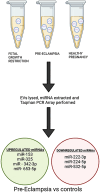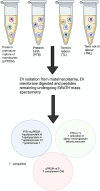Extracellular vesicles as markers and mediators of pregnancy complications: gestational diabetes, pre-eclampsia, preterm birth and fetal growth restriction
- PMID: 37070801
- PMCID: PMC11497252
- DOI: 10.1113/JP282849
Extracellular vesicles as markers and mediators of pregnancy complications: gestational diabetes, pre-eclampsia, preterm birth and fetal growth restriction
Abstract
In high income countries, approximately 10% of pregnancies are complicated by pre-eclampsia (PE), preterm birth (PTB), fetal growth restriction (FGR) and/or macrosomia resulting from gestational diabetes (GDM). Despite the burden of disease this places on pregnant people and their newborns, there are still few, if any, effective ways of preventing or treating these conditions. There are also gaps in our understanding of the underlying pathophysiologies and our ability to predict which mothers will be affected. The placenta plays a crucial role in pregnancy, and alterations in placental structure and function have been implicated in all of these conditions. As extracellular vesicles (EVs) have emerged as important molecules in cell-to-cell communication in health and disease, recent research involving maternal- and placental-derived EV has demonstrated their potential as predictive and diagnostic biomarkers of obstetric disorders. This review will consider how placental and maternal EVs have been investigated in pregnancies complicated by PE, PTB, FGR and GDM and aims to highlight areas where further research is required to enhance the management and eventual treatment of these pathologies.
Keywords: extracellular vesicles; fetal growth restriction; gestational diabetes; placenta; pre-eclampsia; pre-term birth.
© 2023 The Authors. The Journal of Physiology published by John Wiley & Sons Ltd on behalf of The Physiological Society.
Conflict of interest statement
No competing interests declared
Figures






Similar articles
-
Extracellular Vesicles in Feto-Maternal Crosstalk and Pregnancy Disorders.Int J Mol Sci. 2020 Mar 19;21(6):2120. doi: 10.3390/ijms21062120. Int J Mol Sci. 2020. PMID: 32204473 Free PMC article. Review.
-
The ability of late pregnancy maternal tests to predict adverse pregnancy outcomes associated with placental dysfunction (specifically fetal growth restriction and pre-eclampsia): a protocol for a systematic review and meta-analysis of prognostic accuracy studies.Syst Rev. 2020 Apr 8;9(1):78. doi: 10.1186/s13643-020-01334-5. Syst Rev. 2020. PMID: 32268905 Free PMC article.
-
Changes in Circulating Kisspeptin Levels During Each Trimester in Women With Antenatal Complications.J Clin Endocrinol Metab. 2022 Jan 1;107(1):e71-e83. doi: 10.1210/clinem/dgab617. J Clin Endocrinol Metab. 2022. PMID: 34427658 Free PMC article.
-
Abnormal placental CD8+ T-cell infiltration is a feature of fetal growth restriction and pre-eclampsia.J Physiol. 2020 Dec;598(23):5555-5571. doi: 10.1113/JP279532. Epub 2020 Sep 16. J Physiol. 2020. PMID: 32886802
-
Extracellular Vesicles and Preeclampsia: Current Knowledge and Future Research Directions.Subcell Biochem. 2021;97:455-482. doi: 10.1007/978-3-030-67171-6_18. Subcell Biochem. 2021. PMID: 33779928 Review.
Cited by
-
Analyzing molecular signatures in preeclampsia and fetal growth restriction: Identifying key genes, pathways, and therapeutic targets for preterm birth.Front Mol Biosci. 2024 Apr 22;11:1384214. doi: 10.3389/fmolb.2024.1384214. eCollection 2024. Front Mol Biosci. 2024. PMID: 38712342 Free PMC article.
-
Regulation of placental amino acid transport in health and disease.Acta Physiol (Oxf). 2024 Jul;240(7):e14157. doi: 10.1111/apha.14157. Epub 2024 May 6. Acta Physiol (Oxf). 2024. PMID: 38711335 Free PMC article. Review.
-
Placental Protein Citrullination Signatures Are Modified in Early- and Late-Onset Fetal Growth Restriction.Int J Mol Sci. 2025 Apr 29;26(9):4247. doi: 10.3390/ijms26094247. Int J Mol Sci. 2025. PMID: 40362485 Free PMC article.
-
Extracellular vesicles and preterm infant diseases.Front Pediatr. 2025 Feb 17;13:1550115. doi: 10.3389/fped.2025.1550115. eCollection 2025. Front Pediatr. 2025. PMID: 40034714 Free PMC article. Review.
-
A Review of Dietary and Lifestyle Management of Pre-Eclampsia and Postpartum Eclampsia.Prev Nutr Food Sci. 2025 Feb 28;30(1):1-20. doi: 10.3746/pnf.2025.30.1.1. Prev Nutr Food Sci. 2025. PMID: 40059912 Free PMC article. Review.
References
-
- Alshabibi, M. A. , Khatlani, T. , Abomaray, F. M. , AlAskar, A. S. , Kalionis, B. , Messaoudi, S. A. , Khanabdali, R. , Alawad, A. O. , & Abumaree, M. H. (2018). Human decidua basalis mesenchymal stem/stromal cells protect endothelial cell functions from oxidative stress induced by hydrogen peroxide and monocytes. Stem Cell Research and Therapy, 9(1), 275. - PMC - PubMed
-
- American College of Obstetricians and Gynecologists (2020). Gestational hypertension and preeclampsia: ACOG Practice Bulletin Summary, Number 222. Obstetrics and Gynecology, 135(6), 1492–1495. - PubMed
Publication types
MeSH terms
Grants and funding
LinkOut - more resources
Full Text Sources
Research Materials
Miscellaneous

